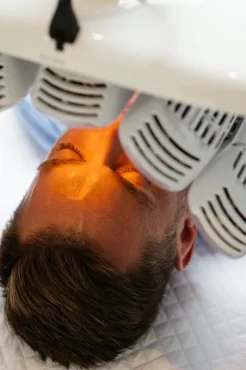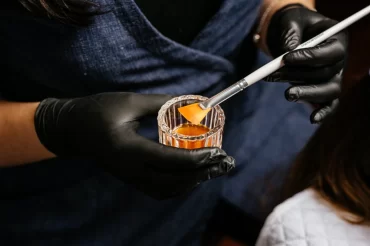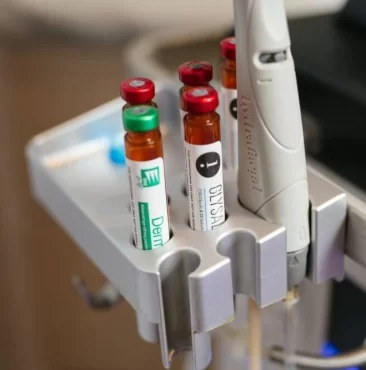Sensitive Skin

Sensitive skin can present in many ways and may include dryness, irritation, or reactivity to skincare and environmental factors.
Sensitive skin is a broad term used to describe skin that is easily irritated by products, environmental triggers, or external factors. It is not a formal medical diagnosis and can present in many ways i.e redness, dryness and peeling through to stinging, burning, or itching without visible changes.
Skin sensitivities may occur across the body but are often noticed on the face, eyelids, and other delicate areas such as the underarms, groin or skin folds. Many people find sensitivities fluctuate over time and can be influenced by lifestyle, environment and product use.
In accordance with Therapeutic Goods Administration (TGA) regulations, we are unable to provide detailed information about specific treatments online. Such information may be misinterpreted as the promotion of prescription-only (Schedule 4) medications – this is not permitted under TGA guidelines.
For this reason, a consultation with one of our practitioners is required. During your comprehensive consultation, your practitioner will carefully assess your skin, discuss your concerns, and provide education around suitable treatment options. A personalised treatment plan will then be created to address your individual needs.
Treatment costs will vary depending on your tailored plan and will be discussed with you in detail during your consultation.
FAQs
What causes sensitive skin?
Please note that the below information is not intended to assist with medical diagnosis or management.
It is essential any patient with these conditions are under the care of a General Practitioner or Dermatologist and a correct diagnosis has been made. The below is for informative purposes only.
Common causes of sensitive skin include:
- Food intolerances; gluten, dairy, highly acidic foods.
- Environmental factors; weather, pollutants, pollen, dust
- Stress and anxiety
- Nutrient deficiencies
- Topical Irritants; perfume, jewellery, skin products
- Sensitive skin is oven caused by overuse of certain products and treatments
- Each individual can have different triggers.
How does it manifest?
Sensitive skin can present in many ways, including:
- Burning, stinging, or itching sensations
- Redness or flushing
- Dryness, flaking or peeling
- Visible irritation such as bumps, hives or patches
- General intolerance to products that were once well tolerated
What are the types of skin sensitivity?
Impaired Skin Barrier
When the skin barrier is impaired, such as from the use of irritant cosmetics, overuse of products or trauma it can become highly sensitive to irritants. Impaired barrier can be caused by dehydration, nutrient deficiencies, prolonged use of skin products high in ingredients which are stripping to the skin .It presents often with stinging, burning and diffuse redness with skin prone to breakouts and dehydration.
Irritant Contact Dermatitis
The term sensitive skin is most often used to describe a condition called irritant contact dermatitis. This is when the skin mounts an inflammatory response to an irritant (which is applied to the skin). It is NOT due to an allergy to that irritant. Symptoms include redness, itch, hives and blistering. Common skin irritants include chemicals, body fluids, heat/cold, humidity, pressure, friction and other mechanical factors. Those with a history of eczema may be more prone to irritant contact dermatitis. Other possible contributing factors include age, gender and skin site.
Allergic Contact dermatitis
This is a skin sensitivity that results from an allergic response to an externally applied agent to the skin. This is much more rare than irritant contact dermatitis. As with most allergic reactions, the response will become worse with ongoing exposure to the allergen and people who suffer from this condition report worsening symptoms over time. The causative agent can be determined by skin patch testing with a dermatologist. Common allergens include animal dander, grasses, pollen and cosmetics.
Eczema/Dermatitis
Eczema presents with an itchy rash and dryness of the skin. All forms of eczema can result in sensitive and irritated skin with an impaired barrier function. The skin becomes more irritated due to the impaired barrier function as even more irritants can enter the skin. Triggers can include temperature, humidity, environmental factors as well as internal factors. It is common for eczema to present with other skin sensitivities such as irritant or contact dermatitis which can make diagnoses of the other conditions difficult.
Rosacea
Rosacea is a common condition characterised by persistent redness, flushing, broken capillaries and skin sensitivity. The skin is often easily irritated especially after the use of topical skin products. Common triggers are perfumes and cosmetics. Many patients report sudden reactions to products they have used for years. In rosacea is it important to cease all products and cosmetics that may cause a reaction.
Dry skin
Skin that is chronically dry and dehydrated can present as sensitive and easily irritated. Often environmental factors such as low humidity and cold temperatures can trigger dryness. The over use of skin care products, over washing of the face and certain medications can also cause dryness. Many patients try to help their dry skin by using lots of products which in turn can cause an irritant contact dermatitis.
Seborrheic Dermatitis
In infants this is commonly known as cradle cap. During adulthood sufferers can experience this in areas in which are typically oily. This presents as red, dry patches and dandruff.
What are our recommended treatments?
As with many of the treatment recommendations at Youth Lab, a combination of treatments may be required for optimal results.
Please note that the below is a reference point and full treatment recommendations will be made following a consultation.
If you have ongoing or severe skin sensitivity, it is important to see a GP or dermatologist for diagnosis and medical management. At Youth Lab, our role is to provide supportive, in-clinic treatments that may assist with maintaining skin hydration, strengthening the skin barrier and improving comfort.
Healite II LED
The Healite II LED uses light-based technology at specific wavelengths to support skin health and assist with visible signs of sensitivity. It may help calm the skin and promote a refreshed, balanced appearance.
Medical Peels
Gentle enzyme and mandelic acid peels can help improve the appearance of dry or dull skin and support overall skin balance. These treatments aim to maintain hydration and comfort while gently resurfacing the skin.
Hydrafacial
Once inflammation is settled, the Hydrafacial can assist in refreshing the complexion by removing surface buildup and infusing antioxidant-rich serums to help restore hydration and skin vitality.
BBL Corrective
BBL (Broadband Light) uses light-based technology to address visible redness and uneven tone in suitable clients. This approach supports clearer, more balanced-looking skin over time.
Your practitioner will assess your skin and recommend a tailored plan that focuses on maintaining hydration, protecting the skin barrier, and supporting visible improvements in texture and tone.



